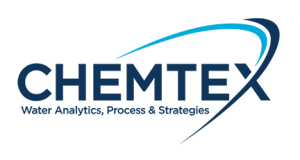
Case Study: Office Complex
Here’s the story of how Chemtex crafted a money-saving solution for a pair of high-rises in one of the Southeast states.
We consulted on a pair of high-rise office buildings. Both buildings had cooling towers operating at eight cycles of concentration, which is a typical cycle of concentration (COC) for the area.
While the city has some of best (and easiest to treat) water in the United States, it’s also burdened by some of the highest water and sewer charges in the nation.
Chemtex analyzed the situation and crafted a two-prong solution. First, we proposed operating at a higher COC. To ensure the higher COC was sustainable, we determined a suitable corrosion and scale inhibitor to protect the cooling equipment.

Higher Cycle of Concentration Yields Savings
Here are the numbers.
The two buildings average out at approximately 500,000 square feet each.
Operating the cooling tower at eight cycles of concentration (COC) during warm months (eight months of the year) consumes approximately 450,000 gallons per month of makeup water. The corresponding tower blow down is approximately 56,000 gallons per month, with evaporation accounting for 394,000 gallons per month.
The municipality offers evaporation credits for the sewer portion of the bill. Meters on both makeup and blow down reveal the amount of water evaporated, and thus not subject to the sewer charge. During the eight warm months the property is looking at total seasonal blow down utility costs of nearing $12,000 per year.
Using computer simulation, Chemtex calculated how many cycles of concentration could safely be run based on local water quality. The simulation indicated 15 COC. With this higher COC, a well-controlled corrosion and scale inhibitor is essential. Chemtex implemented a florescent traced inhibitor, controlled in real time with a Little Dipper probe tied to the cooling tower controller, which turns the pump on and off.
We methodically moved up the conductivity set point to achieve 15 COC. Assuming evaporation stays at 394,000 gallons per month, we predicted the blow down would be reduced to 28,143 gallons per month, and overall makeup water would be reduced to 422,143 gallons per month.
Reducing the cooling tower blow down by 27,857 gallons per month produced a monthly savings of around $750. Compound that over the eight-month cooling season, and the building operators were pleased to net a savings of nearly $6,000 per year. That savings actually pays for a significant portion of the chemical water treatment for the building each year.
A Chemtex Simulation Can Identify Savings
Are you running at the optimal COC? Invite Chemtex to evaluate your cooling program. We’ll run simulations and crunch numbers, helping you find the most economical solution for your specific circumstances.



/NQA-ISO-9001-Logo-ANAB.jpg)